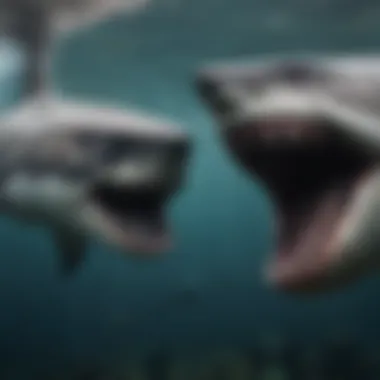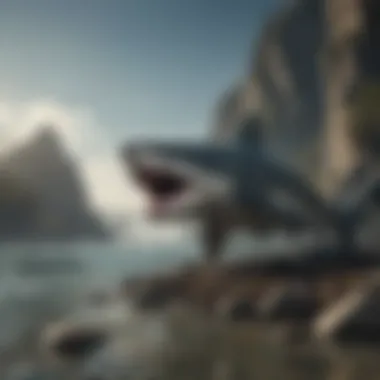The Extinction of the Megalodon: Ancient Sharks Unveiled


Intro
The megalodon, a titan of the oceans, remains a subject of fascination and intrigue. With estimates suggesting it could reach lengths of up to 60 feet, this ancient shark occupied a unique position in marine ecosystems. Its extinction, which occurred around 3.6 million years ago, raises questions about its ecological role and the environmental factors that contributed to its demise. As paleontologists uncover more fossil records and analyze ancient marine conditions, the complexities surrounding the megalodon's extinction become clearer.
Understanding the megalodon's history cannot be a mere exploration of its size or power. Instead, it necessitates a comprehensive examination of its evolutionary background, the interdependencies within marine ecosystems, and the historical circumstances leading to its decline.
This article aims to navigate through these layers, providing an in-depth view of the megalodon's extinction while emphasizing its significance in today's marine conservation discussions.
Featured Collectible of the Month
Overview
Among the various fossils of the megalodon, teeth are the most frequently discovered. They serve as remarkable collectibles, illustrating not only the size of the creature but also its predatory nature. These teeth can be substantial, sometimes measuring over seven inches in length, and exhibit unique serrations that reveal their functionality. Collectors highly value megalodon teeth, with prices varying based on size, condition, and provenance.
Historical Significance
Megalodon teeth hold crucial insights into the prehistoric environments and the behaviors of this apex predator. From their strength, we can infer the megalodon's feeding strategies and its interactions with other marine life. The geographic spread of these teeth also gives us an idea of its vast habitat. Ultimately, owning a megalodon tooth is not only about possessing a piece of history; it is about holding a fragment of the complex narrative of evolution and extinction.
Identification Techniques
Visual Characteristics
When attempting to identify megalodon teeth, collectors should consider several key features:
- Size: Adult megalodon teeth can be impressively large, often exceeding five inches.
- Shape: The teeth have a broad triangular shape with pronounced serrations.
- Coloration: They can vary in color, from black to brown, and even white, influenced by the mineralization process over millions of years.
Resources for Identification
Accurate identification of megalodon teeth often requires consultation of reliable sources. Some recommended resources include:
- Wikipedia: A starting point for general information.
- Britannica: Offers more detailed insights on the biology and history of megalodons.
- Reddit: Various communities dedicated to fossil hunting and collecting can provide advice and share experiences.
- Facebook Groups: Niche groups focused on fossils may also offer connections and resources for discerning collectors.
By employing these identification techniques and leveraging these resources, collectors can enhance their understanding of the megalodon while also expanding their collections responsibly. The importance of preserving such historical remnants cannot be overstated, as they serve as a reminder of the ecological shifts that lead to the loss of such magnificent creatures.
Understanding the Megalodon
The subject of the megalodon is crucial to comprehending the vast marine ecosystems of yesteryear. Studying this prehistoric shark not only sheds light on the physical characteristics and behaviors of ancient predators but also helps us to understand their role in the ecological hierarchy of their time. The megalodon's existence and eventual extinction offer insights into the delicate balance that governs marine life today. Recognizing such connections is essential for both paleontological research and conservation efforts.
Morphological Characteristics
Size and length
The size of the megalodon was remarkable. Estimates suggest it could grow up to 60 feet, making it one of the largest sharks known to have ever existed. This size factor is significant because it placed the megalodon at the top of the food chain. Its immense length allowed it to dominate other marine species and ensured it had few natural predators. The sheer scale serves as a point of fascination. However, such size also means it required vast amounts of food, which might have been a disadvantage as prey populations shifted over time.


Jaw structure
Megalodon's jaw structure was powerful and distinctive. It had a massive jaw that could open wide enough to consume large prey. This characteristic was important in understanding how it hunted and its feeding behaviors. The jaw bones were reinforced and capable of delivering crushing force, necessary for breaking through the tough skins of marine animals. However, the robust nature of its jaw also had limitations – it could only be effective in environments where abundant prey existed.
Teeth anatomy
The teeth of the megalodon are some of the most well-preserved fossils found. They were large, serrated, and suited for gripping and slicing through flesh. Their anatomy highlights an adaptation that is critical in identifying how these sharks interacted with their environments. The unique design of these teeth made them effective for their diet, which consisted of large marine animals. However, finding such teeth also raises questions about the megalodon's hunting strategies and implications for its extinction.
Habitat and Range
Geological timeline
Understanding the geological timeline gives context to the megalodon's existence. It roamed the oceans approximately 23 to 2.6 million years ago during the Cenozoic Era. This era witnessed significant ecological shifts and changes in oceanic conditions. Knowledge of the geological periods in which the megalodon thrived allows for better comprehension of the environmental conditions that contributed to its eventual decline. Recognizing these timeframes is beneficial for piecing together the evolution of marine predators.
Geographical distribution
The geographical distribution of the megalodon spanned much of the world's oceans, covering areas from the Americas to Europe and beyond. This extensive range illustrates its adaptability and resourcefulness as a predator. Such information is vital to understand how the megalodon interacted with different marine environments and how specific climate conditions influenced its habitat. By exploring these aspects, we can gain insight into other marine species' distribution patterns.
Preferred environments
Megalodon's preferred environments included warm, nutrient-rich waters, often found along coastlines and continental shelves. These areas provided ample hunting grounds and suitable conditions for growth and reproduction. The preference for such habitats signifies its ecological needs and influences its survival and extinction. The implications of such preferences allow us to explore modern predators' behavior and habitat requirements in current marine ecosystems.
"The discovery and analysis of megalodon fossils continue to shape our understanding of prehistoric marine life and highlight the interconnectedness of biodiversity."
By examining the morphological characteristics, habitat, and range of the megalodon, we can appreciate its role in ancient ecosystems and start to connect its story to the ongoing challenges facing marine life today.
Evolutionary Context
Understanding the evolutionary context of the megalodon is vital in shedding light on the characteristics that defined this ancient predator. It allows us to connect the megalodon's biology and behavior to its ancestors and modern relatives. This context is essential not just for presenting a detailed overview of the megalodon itself, but also for appreciating the broader evolutionary narrative of sharks. Investigating this evolutionary journey informs us about adaptation strategies and ecological roles within marine environments. Furthermore, this exploration helps us to comprehend the factors that could have contributed to the extinction of the megalodon and gives insights into the biological mechanisms that influence species survival.
Ancestry of the Megalodon
Shark evolution overview
The evolution of sharks is a complex narrative that traces back hundreds of millions of years. Sharks have been present in the oceans since the Devonian period, demonstrating remarkable adaptability. This ancient lineage shows various morphological adaptations that have allowed them to thrive across different geological epochs. The key characteristic of this evolution is the presence of cartilaginous skeletons, which are lighter and more flexible than bony structures, allowing for efficient movement in water. This aspect of shark evolution highlights their evolutionary potential, making it a beneficial focus within this article. However, the unique feature of the evolutionary history of sharks is the extensive fossil record, showcasing a wide diversity of forms and sizes. This extensive record allows paleontologists to track changes in shark morphology through time and assess the evolutionary pressures that shaped the megalodon.
Relation to modern sharks
The relation of the megalodon to modern sharks is a critical aspect of shark evolution. The megalodon, belonging to the family Lamnidae, shares common ancestry with several modern species, including the great white shark. Understanding these relationships provides context for the ecological roles these sharks played. The key characteristic that underscores this relationship is the comparison of morphological features. For instance, the similarity in jaw structure between megalodon and its modern relatives facilitates discussions on feeding behaviors and predatory strategies. This relationship enriches the discussions in this article, but also poses a unique challenge—while connections can be drawn, the distinct size and ecological role of the megalodon set it apart from present-day sharks, thereby complicating direct comparisons.
Genetic studies
Genetic studies have become an important tool in understanding the megalodon's existence in the context of shark evolution. Analysis of mitochondrial DNA from existing shark species provides insights into the evolutionary pathways leading to the megalodon. The notable feature of these studies is their ability to identify subtle genetic similarities and divergences among species. This characteristic makes genetic studies a beneficial choice for this article as they offer empirical data to support evolutionary hypotheses. However, the challenge lies in the limited genetic material available from extinct species, which can hinder comprehensive analysis. Despite these limitations, genetic studies play a crucial role in elucidating the megalodon's evolutionary history and its connection to contemporary sharks.


Ecological Role
Apex predator status
The megalodon held the status of apex predator in its ecosystem. This role is significant because apex predators are crucial for maintaining the balance of marine life. The key characteristic of apex predators is their position at the top of the food chain, which allows them to regulate the population of prey species. Understanding the megalodon’s apex status emphasizes its influence on marine ecology and showcases the significance of its extinction. However, this status also brings attention to the unique challenge of assessing its impact, as the complete absence of the megalodon opens up ecological niches and may lead to imbalances in current ecosystems.
Prey species and feeding habits
Investigating the prey species and feeding habits of the megalodon reveals much about its ecological dynamics. The megalodon is known to have fed on large marine mammals and other sharks, exhibiting behaviors indicative of powerful predation. The significant characteristic here is the anatomical design of the megalodon's teeth, which were well-suited for grasping and tearing flesh. This aspect is central in discussing how the megalodon’s feeding habits shaped its environment. However, detailed knowledge about its specific prey can be challenging to pin down, given the limited fossil evidence.
Impact on marine ecosystem dynamics
The impact of the megalodon on marine ecosystem dynamics is profound. As a top predator, its existence influenced various species populations, prompting adaptive responses in prey and competing species. The key characteristic of this impact lies in the cascading effects that result from predator-prey relationships. Its role in shaping the structure of marine communities makes this a valuable area of exploration for this article. The challenge arises from the need to hypothesize about its impact based on fossilized evidence and ecological models, as direct observation is impossible. Nevertheless, understanding the megalodon’s ecological role provides critical insights into the functioning of ancient marine ecosystems and the implications of its extinction for contemporary wildlife.
The Extinction Debate
Understanding the extinction of the megalodon is crucial for comprehending ancient marine ecosystems. The megalodon, as a dominant predator, played a significant role in shaping ocean life. Its disappearance raises key questions about environmental changes that can lead to the decline of apex predators. The debate around its extinction encompasses various aspects, including evidence gathering and theories regarding causes. By examining this topic, one gains insight into the relationships within ecosystems and their vulnerability influences from both natural and anthropogenic factors.
Evidence of Extinction
Fossil records
Fossil records offer compelling evidence for studying the megalodon's extinction. They present a chronological narrative of the species' existence, helping scientists identify patterns in its presence and eventual disappearance. One of the key characteristics of fossil records is their ability to provide tangible proof of past life forms. They serve as a beneficial choice for research, as they allow for dating and contextualizing megalodon remains in connection to their environments. However, the unique feature of fossil records is their incompleteness. Not all species leave behind these indicators, which can complicate definitive conclusions.
Last known sightings
The last known sightings of the megalodon are another critical area of investigation. They help pinpoint the timeline of the species' vanishing act. The key characteristic here is that these sightings can sometimes be anecdotal, relying on human observation rather than scientific data. This aspect makes it a popular but controversial choice for research. The unique feature in this context is the intertwining of folklore and scientific inquiry. While captivating, such sightings may lack the rigor of fossil data, which can lead to misconceptions about the timeline and reasons behind the megalodon's extinction.
Comparative analysis with contemporary sharks
A comparative analysis of the megalodon with contemporary sharks enriches our understanding of evolutionary changes over time. The key characteristic of this analysis is the focus on anatomical and behavioral traits shared and diverged among species. This approach is beneficial because it sheds light on evolutionary adaptations and survival strategies in changing environments. The unique feature here involves studying traits such as bite force and hunting patterns, which can vary extensively between the megalodon and its modern relatives. However, this comparative method can also face limitations because contemporary sharks may not represent the full range of historical ecologies that existed.
Potential Causes of Extinction
Climate change and ocean temperatures
Climate change and ocean temperatures present potential root causes for the megalodon extinction. The relevance of this subject is significant given that temperature shifts influence the distribution of marine species. One critical characteristic is the historical data on ocean temperatures during the megalodon's decline. This aspect makes climate change a widely discussed reason for extinction. The unique feature here is the ongoing debate over the pace and extent of these environmental changes. While some argue that gradual shifts contributed to habitat loss, others point to rapid events that might have had a more immediate impact on megalodon populations.
Decline in prey availability
The decline in prey availability is another major facet of the extinction discussion. Megalodons preyed on large marine mammals and other substantial fish. One key characteristic is the interdependency of species within the food web. Understanding this relationship is crucial to analyzing the megalodon's fate. This factor makes it a beneficial choice for exploring ecological dynamics. The unique feature lies in the fact that changes in prey populations can reflect broader environmental shifts. However, understanding the full impact may be limited by incomplete prey data from that era.
Competition with other marine species


Competition with other marine species is a primary factor in addressing the megalodon’s eventual disappearance. This topic is important as it provides insight into predatory relationships and survival competition. A critical characteristic involves examining how emerging predators might have exploited resources, impacting the megalodon's ability to thrive. This aspect makes competition a fascinating area because it speaks to the adaptability of ecosystems. The unique feature is that this competition could drive species to either adapt rapidly or face extinction. Still, making clear conclusions can be challenging, owing to the intricate nature of marine ecosystems and available data.
Implications for Modern Marine Ecosystems
The extinction of the megalodon has notable implications for today's marine ecosystems. Understanding its disappearance helps in grasping the delicate balance within marine food webs. The lessons learned from this ancient predator can inform our current approaches to marine conservation and management. Analyzing the factors that led to the megalodon’s extinction may provide insights into how modern species might face similar challenges due to environmental shifts. Moreover, it underscores the need for biodiversity preservation, highlighting how the loss of one apex predator can destabilize an entire ecosystem.
The Cultural Impact of the Megalodon
The megalodon has left a significant mark on human culture, reflecting both fascination and a deeper understanding of ancient life. This section offers insight into how the megalodon influences modern media and public perception, establishing a compelling narrative that connects past marine predators with present-day ecological concerns.
Megalodon in Popular Culture
Representation in media
The representation of megalodon in various forms of media has greatly shaped public interest in this ancient shark. Films such as "Sharknado" and "The Meg" dramatize the size and ferocity of the megalodon, making it an engaging subject for audiences. This portrayal contributes to the overarching narrative of the megalodon as a formidable predator, capturing the imagination of viewers.
One key characteristic of its representation is the emphasis on its colossal size. By highlighting this, filmmakers engage audiences with thrilling visuals. However, this dramatization might distort scientific realities. The unique feature of megalodon in media is the combination of entertainment and pseudo-science, which can lead to misconceptions about actual shark behaviors and traits.
Symbol of prehistoric power
The megalodon often symbolizes prehistoric power and dominance in the marine environment. As the apex predator of its time, it evokes awe and intrigue about natural history. This aspect makes it a popular choice for documentaries and literature that aim to instill wonder about ancient ecosystems.
A major advantage of this symbol is its ability to connect people to the past. It allows for discussions about evolution and extinction in a broad context. However, this focus may sometimes overshadow the ecological narrative, reducing the shark to merely a monstrous figure rather than a crucial part of marine history.
Influence on public perception of sharks
Public perception of sharks has been greatly influenced by the megalodon. Often regarded as the ‘ultimate’ shark, it evokes fear and admiration simultaneously. This dual perception can affect how contemporary shark species are viewed, often leading to a misunderstanding of their ecological significance.
The portrayal of megalodon as a vicious creature might lead to exaggerated fears of modern sharks, overshadowing their vital roles in ocean ecosystems. While raising awareness, this influence can be a double-edged sword. It benefits by driving interest in marine biology, yet it can foster harmful stereotypes about all sharks being dangerous.
Scientific Inquiry and Public Interest
Community engagement with paleontology
Community engagement in paleontology has opened avenues for broader understanding of extinct species like the megalodon. Scientific initiatives often involve workshops and outreach programs that encourage participation in fossil discoveries. This engagement connects enthusiasts with professionals, enhancing appreciation for marine history.
A key characteristic of this community involvement is its accessibility, allowing individuals of varied backgrounds to learn and contribute. Such programs can foster a sense of ownership over discoveries. However, engaging the public also demands careful communication to ensure that information is presented accurately and responsibly.
Impact on educational curricula
The impact of megalodon on educational curricula is profound. Schools and universities often include discussions about prehistoric life, using the megalodon as a focal point. This offers an engaging framework for teaching about evolution, marine biology, and environmental science.
This integration into education is beneficial because it sparks interest in science among students. By linking historical findings with contemporary issues, educators can highlight the importance of biodiversity. Nevertheless, there is a risk of oversimplifying complex subjects, which requires balancing engagement with scientific rigor.
The role of museums and exhibitions
Museums and exhibitions play a critical role in shaping the narrative surrounding the megalodon. They provide platforms for displaying fossils and related findings, offering visitors a tangible connection to the past. Many exhibitions utilize interactive displays that educate about both the megalodon and marine ecosystems.
A standout feature of these venues is their ability to present scientific information in an accessible manner. They often encourage curiosity and provide context on the importance of marine conservation. However, presenting the megalodon primarily as an exhibit can sometimes underrepresent the broader environmental issues that led to their extinction.



